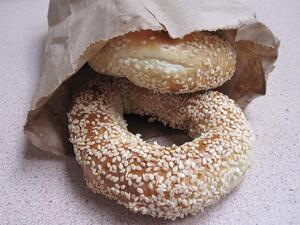Eating Jewish: Bagels
My neighborhood in Montreal, called Mile End, is known for hipsters, Chasidic Jews and bagels. Although each of these topics could potentially make for an interesting blog post, it is, of course, the bagel that I would like to discuss. I absolutely love bagels and have been eating them for as long as I can remember. Living in walking distance of two of the most famous bagel shops in the city means that they’re on the menu very often. I eat them at breakfast, lunch and dinner, but also as a late night snack when a plate and a knife aren’t necessary and the best way to eat them is dipped straight into the container of cream cheese or smoked salmon spread.
Of course, the bagels that I’m talking about are those, which Montreal has become famous for and which are different to their counterparts that are found in New York. I understand that loyalties run deep when it comes to a discussion of which bagel people think is the best, as evidenced in this City Room blog post and the various comments it received. Everyone will have their own preference, but what I would like to focus on here is the history and status of the bagel within the Jewish community.
The history and origins of the bagel have been greatly discussed and written about, with whole books such as this one being devoted to this round ubiquitous bread. As with many foods, it is difficult to determine its exact origins. One legend that I have come across in a few places, The World of Jewish Cooking by Gil Marks being one of them, says that bagels were invented in 1863 by a non-Jewish baker (although some say he was Jewish) in Vienna, who called them buegel (stirrup) in order to honor a Polish prince and his cavalry for their role in a victory over the Turks. According to Claudia Roden, bagels are of South German origin but came to be the bread we know today in Polish shtetls. Bagels were the everyday bread of Jews living in eastern Europe and they were sold on streets by vendors who transported them in baskets or on long sticks. It was also common for housewives in eastern Europe to prepare bagels in their homes to be sold by their husbands or children, in order to supplement the family income. The cookbook author, Gil Marks, writes of buying bagels from an elderly eastern European woman who continued this practice of making and selling her own bagels when he was younger. Do you have any similar memories of a woman you knew doing the same? Furthermore, it was also once believed that bagels could function as protection against demons and evil spirits, as well as having the ability to ward off the evil eye and bring good luck. This lead to pregnant women wearing bagels around their neck for protection and having bagels served while they were in labor.
It was with the arrival of Jewish immigrants from eastern Europe that the bagel was introduced into North America where they have become so integrated into the mainstream, that not only are they readily eaten by both Jews and non-Jews alike but they have also come to be representative of the cities in which they have long been produced.
Although I don’t make bagels myself because of my close proximity to bakeries in Montreal, I’ve included a recipe for Montreal-style bagels, which are sweeter and lighter than New York bagels. Whether this will be your first taste of a Montreal bagel or a chance to try your own hand at making them, I hope that you enjoy this bread that has been so integral to the Ashkenazi Jewish community.
Montreal Bagels
From Marcy Goldman’s A Treasury of Jewish Holiday Baking
1 ¾ cups water
2 ½ teaspoons dry yeast or ½ ounce fresh yeast
5 tablespoons plus a pinch of sugar
2 tablespoons beaten egg
3 tablespoons vegetable oil
1 tablespoon malt powder
1 ½ teaspoons salt (optional)
4 ½-5 cups bread flour
Kettle Water
6 quarts water
1/3 cup honey
Topping
1 ½ cups sesame or poppy seeds (or half and half)
-
In a large bowl, stir together the water, yeast, and pinch of sugar. Let the mixture stand for a couple of minutes, allowing the yeast to swell or dissolve. (If using fresh yeast, crumble it into the warm water along with the pinch of sugar.) Whisk in the remaining sugar, the beaten egg, vegetable oil, malt, and salt, if using. Fold in most of the flour. Knead for 10 to 12 minutes to form a stiff, smooth dough, adding additional flour as required. Cover with a tea towel or an inverted bowl and let the dough rest for 10 minutes.
-
Line a large baking sheet with a kitchen towel, and another with baking parchment. Fill a large soup pot or Dutch oven with 6 quarts water. Add the honey. Bring the water to a boil. Meanwhile, divide the dough in 12 sections and form each one into a 10-inch strip. Form these into bagel rings and place them on a cookie sheet. Let them rise for 12 to 16 minutes, until they are very slightly puffed up. Preheat the oven to 450 degrees.
-
Boil the bagels for about 1 ½ minutes, turning them once. Place them on the towel-lined sheet to dry out. Then sprinkle very generously with sesame or poppy seeds (Montreal bagels are more seeded than regular bagels) and transfer them to the parchment-lined sheet.
-
Place in the oven, reduce the heat to 425 degrees, and bake until done, 15 to 22 minutes, turning them once when they are just about done and switching baking sheets midway. Alternately, you can start the bagels on a baking sheet and turn them onto a preheated baking stone to finish baking.







